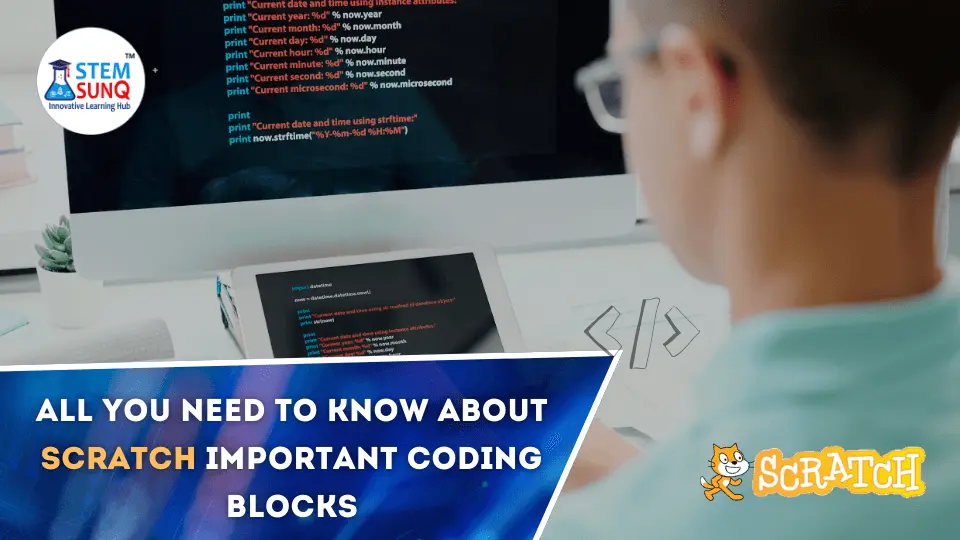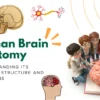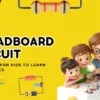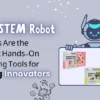
Table of Contents
Scratch, a visual programming language intended for children and beginners, is an effective tool for learning the fundamentals of coding. Its user-friendly interface and colorful coding blocks make programming easy and enjoyable. In this blog post, we will talk about the number of Scratch coding blocks. By the end, you’ll have a thorough understanding of how these blocks work and how they can help you bring your projects to life.
Also Read: Amazing Coding Activities for Kids
What Are Code Blocks in Scratch?
In Scratch, coding blocks are the fundamental programming units. They are visual, draggable blocks that represent various commands or instructions that you can issue to your sprites (characters or objects in your project). Each block type has a distinct color and shape that indicates its purpose and how it can be connected to other coding blocks. Snapping these blocks together allows you to create scripts that define your sprites’ behavior and actions. This block-based approach makes coding more accessible to younger users and those new to programming.
Scratch Important Coding Blocks
Motion Blocks in Scratch
Motion coding blocks are Scratch’s blue-colored blocks that control sprites’ movements. Sprites are the characters and objects in your Scratch projects. Motion blocks allow you to make your sprite move, turn, glide, and even point in a specific direction.
Key Motion Blocks
- Move () Steps: This block moves the sprite forward by a specified number of steps. It’s great for making your sprite walk or fly across the screen.
- Turn () Degrees: This block rotates the sprite by a given number of degrees. Use it to make your sprite turn left or right.
- Go to (): This block moves the sprite to a specific position on the stage or to another sprite. It’s useful for precise positioning.
- Glide () Secs to (): This block makes the sprite glide smoothly to a specified position over a given time. It’s perfect for animations and transitions.
Using these motion blocks creatively can make your Scratch projects more dynamic and interactive. For example, combining the “move” and “turn” blocks can create unique movement patterns, such as a sprite that zigzags across the screen.
Control Blocks in Scratch
Control coding blocks are orange blocks that control the flow of your program. They let you create loops, wait for specific conditions, and even clone sprites. These blocks are essential for introducing logic and interactivity into your projects.
Key Control Blocks
- Wait () Seconds: This block pauses the script for a specified amount of time. It’s useful for creating delays between actions.
- Repeat (): This loop repeats the contained code a specified number of times. Ideal for actions that need to be performed multiple times.
- Forever: This loop runs the contained code indefinitely. It’s often used for continuous actions, like keeping a sprite moving.
- If () Then: This conditional block executes the code inside it only if a specified condition is true. It’s essential for decision-making in your scripts.
Control blocks are the foundation of your Scratch projects, allowing you to specify how and when actions occur. For example, you can use the “repeat” block to make a sprite walk back and forth, resulting in a more engaging animation.
Event Blocks in Scratch
Event coding blocks are yellow blocks that cause scripts to run in response to specific events. They serve as the starting point for most Scratch scripts, responding to key presses, mouse clicks, and messages received by the sprite.
Key Event Blocks
- When Green Flag Clicked: This block starts the script when the green flag (the start button) is clicked. It’s the most common way to begin a Scratch program.
- When () Key Pressed: This block runs the script when a specified key is pressed. It’s great for creating keyboard controls in games.
- When Sprite Clicked: This block triggers the script when the sprite is clicked. Useful for interactive projects where the user can click on characters to interact with them.
- Broadcast () and When I Receive (): These blocks are used to send and receive messages between scripts. They enable complex interactions and coordination between different parts of your project.
Event blocks make Scratch projects more responsive and interactive. With these blocks, you can create projects that respond to user inputs, making them more engaging and enjoyable to use.
Sensing Blocks in Scratch
Sensing coding blocks allow your projects to interact with the environment and other sprites by detecting mouse position, keyboard input, and collisions. They add depth and interactivity to your designs, making them more appealing for users to interact with.
Key Sensing Blocks
- Touching ()?: This block checks if the sprite is touching a specified object, like another sprite or the edge of the stage. It’s useful for detecting collisions.
- Mouse X and Mouse Y: These blocks report the current x and y coordinates of the mouse pointer. They can be used to make sprites follow the mouse.
- Ask () and Wait: This block prompts the user to enter text and pauses the script until an answer is provided. It’s great for interactive projects that require user input.
- Key () Pressed?: This block checks if a specified key is pressed. It’s essential for creating keyboard-controlled games.
Sensing blocks make Scratch projects more interactive by allowing them to respond to user actions and environmental changes.
Looks Blocks in Scratch
Looks coding blocks allow you to alter sprite appearances by changing costumes, sizes, and visual effects. They improve the visual appeal and dynamic elements of your projects, allowing you to bring your creative vision to reality.
Key Looks Blocks
- Switch Costume to (): This block changes the sprite’s costume to a specified one. It’s useful for creating animations.
- Change Size by (): This block alters the sprite’s size by a given amount. It’s great for making sprites grow or shrink.
- Show and Hide: These blocks make the sprite visible or invisible. They’re useful for controlling when sprites appear on the stage.
- Set Color Effect to (): This block applies a visual effect to the sprite, such as changing its color. It’s perfect for adding visual flair to your projects.
Looks blocks allow you to change the appearance of your sprites, making your projects more visually appealing and dynamic.
Operator Blocks in Scratch
Operator coding blocks perform mathematical operations and string handling, allowing for calculations, value comparisons, and text manipulation. They increase computational power, allowing for more complex and dynamic scripts in your projects while also encouraging creativity and problem-solving skills.
Key Operator Blocks
- () + (): This block adds two numbers together. It’s one of several blocks for basic arithmetic operations.
- Join () (): This block combines two text strings into one. It’s useful for creating custom messages.
- () > (): This block checks if one value is greater than another. It’s essential for making comparisons in your scripts.
- Pick Random () to (): This block generates a random number within a specified range. It’s great for adding randomness to your projects.
Operator blocks increase computational power in Scratch projects, allowing you to write more complex and dynamic scripts.
Conclusion
Understanding these Scratch blocks is crucial for creating engaging and interactive projects. These blocks lay the groundwork for movement, logic, and interactivity, allowing you to bring your creative vision to life. Whether creating a simple animation or a complex game, understanding these coding blocks will help you get the most out of Scratch.







